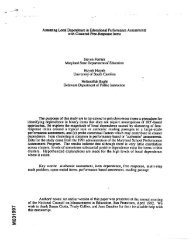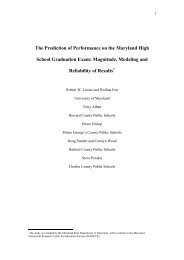A Brief Introduction to Evidence-Centered Design CSE Report 632 ...
A Brief Introduction to Evidence-Centered Design CSE Report 632 ...
A Brief Introduction to Evidence-Centered Design CSE Report 632 ...
Create successful ePaper yourself
Turn your PDF publications into a flip-book with our unique Google optimized e-Paper software.
But off-the-shelf assessments and standardized tests are increasinglyunsatisfac<strong>to</strong>ry for guiding learning and evaluating students’ progress. Advances incognitive and instructional sciences stretch our expectations about the kinds ofknowledge and skills we want <strong>to</strong> develop in students, and the kinds of observationswe need <strong>to</strong> evidence them (Glaser, Lesgold, & Lajoie, 1987). Advances in technologymake it possible <strong>to</strong> evoke evidence of knowledge more broadly conceived, and <strong>to</strong>capture more complex performances. One of the most serious bottlenecks we face,however, is making sense of the complex data that result.Fortunately, advances in evidentiary reasoning (Schum, 1994) and in statisticalmodeling (Gelman, Carlin, Stern, & Rubin, 1995) allow us <strong>to</strong> bring probability-basedreasoning <strong>to</strong> bear on the problems of modeling and uncertainty that arise naturallyin all assessments. These advances extend the principles upon which familiar testtheory is grounded, <strong>to</strong> more varied and complex inferences from more complex data(Mislevy, 1994). One cannot simply construct ‘good tasks’ in isolation, however, andhope that someone down the line will figure out ‘how <strong>to</strong> score it.’ One must designa complex assessment from the very start around the inferences one wants <strong>to</strong> make,the observations one needs <strong>to</strong> ground them, the situations that will evoke thoseobservations, and the chain of reasoning that connects them (Messick, 1994). Morecomplex statistical models may indeed be required, but they evolve from thesubstance of the assessment problem, jointly with the purposes of the assessmentand the design of the tasks.The evidence-centered design (ECD) project at Educational Testing Serviceprovides a conceptual design framework for the elements of a coherent assessment,at a level of generality that supports a broad range of assessment types, from familiarstandardized tests and classroom quizzes, <strong>to</strong> coached practice systems andsimulation-based assessments, <strong>to</strong> portfolios and student-tu<strong>to</strong>r interaction. Thedesign framework is based on the principles of evidentiary reasoning (Mislevy,Steinberg, & Almond, 2003) and the exigencies of assessment production anddelivery (Almond, Steinberg, & Mislevy, 2002). <strong>Design</strong>ing assessment products insuch a framework ensures that the way in which evidence is gathered andinterpreted bears on the underlying knowledge and purposes the assessment isintended <strong>to</strong> address. The common design architecture further ensures coordinationamong the work of different specialists, such as statisticians, task authors, deliveryprocessdevelopers, and interface designers. While the primary focus ofmeasurement specialists is building, fitting, testing, and reasoning from statistical2






